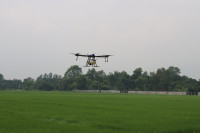Sudurpaschim Province
Annual tiger count begins in Shuklaphanta National Park
Camera traps have been installed across 101 grids for the 21-day census.
Bhawani Bhatta
Annual tiger count has commenced in Shuklaphanta National Park (SNP), the country’s second youngest national park, in Kanchanpur district.
Along with the national tiger census held every four years, the SNP in coordination with other conservation agencies started monitoring and counting tigers in the park area annually from 2020. Federal Minister for Forest and Environment Ain Bahadur Shahi formally inaugurated this year’s census on Friday.
The tigers will be tracked and counted using a camera trapping method, for 21 days. According to Purushottam Wagle, a conservation officer at the SNP, the national park area has been divided into 101 grids, each measuring 2 km by 2 km, with two automated cameras installed in each grid to count the big cats.
“Camera installation is underway in the forest area. We will begin monitoring the tigers on a daily basis as soon as the setup work is complete,” said Wagle. According to him, the cameras have been mounted around one and a half feet above the ground to capture pictures at the animal’s height.
In the past, due to a shortage of cameras, the national park used to fix cameras in certain grids for 15 days and then shift them to other grids. But this time, the cameras have been fixed across the national park area simultaneously.
Shuklaphanta is one of the major habitats of tigers in the country. According to the annual count conducted in 2023, the number of adult tigers was 44, including 14 males, in the Shuklaphanta area.
The ongoing tiger count in Shuklaphanta is jointly conducted by the SNP, the National Trust for Nature Conservation (NTNC) and Zoological Society of London. According to Laxmi Raj Joshi, chief of Shuklaphanta Conservation Programme of the NTNC, cameras have been fixed also in the Chure forest areas of the national park for this year’s count. “There were 92 grids in last year’s count. This time nine additional grids have been added in the Chure region,” said Joshi.
Nepal conducts a national census of tigers every four years. The 2018 census recorded 16 adult big cats in Shuklaphanta while the number rose to 36 in 2022.
Conservationists underscore the need for regular monitoring in areas where the number of tigers is small and the risk of poaching is high. “Tiger populations in protected areas with smaller numbers can dwindle sharply. Also, the risk of poaching in Shuklaphanta, which borders India, is high,” said Naresh Subedi, member secretary at the NTNC.
Subedi asserted that the annual count of tigers is essential in the protected area like Shuklaphanta to prepare strategies to control poaching, manage the habitats and prey animals. “Along with Shuklaphanta, annual tiger census is conducted in Banke and Parsa national parks,” he said, adding that the report of tiger census in Shuklaphanta would be published within three months.
A group of 32 technicians supported by elephants is carrying out the census in Shuklaphanta. “Other technicians could be added if required. We plan to conduct similar counts in other protected areas as well,” said Bhagawan Raj Dahal, Nepal representative of the Zoological Society of London.
Nepal has successfully achieved its goal of doubling the tiger population by 2022, as per its commitment, along with 12 other tiger range countries, the first tiger summit in 2010 in St Petersburg. Tiger population reached 355 in Nepal, according to the latest national count held in 2022. As per the national census, Chitwan National Park has 128 tigers, Bardia National Park has 125, Banke National Park has 25, Parsa National Park has 41 and Shuklaphanta National Park has 36 tigers.
Tiger population is gradually increasing in Nepal over the past few years. In 2010, there were 121 tigers in Nepal. The number rose to 198 in 2013 and 235 in 2018. In the census of 2018, Chitwan National Park was home to 93 tigers and Bardia National Park had 87 tigers. Banke National Park and Shuklaphanta National Park had 21 and 16 tigers, respectively. There were 18 tigers in Parsa National Park.




 15.12°C Kathmandu
15.12°C Kathmandu










%20(1).jpg&w=300&height=200)

